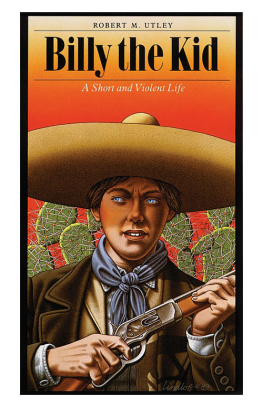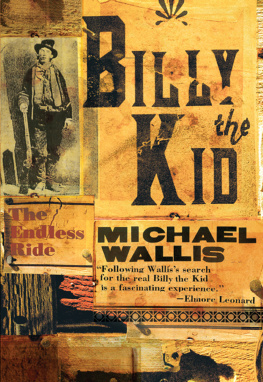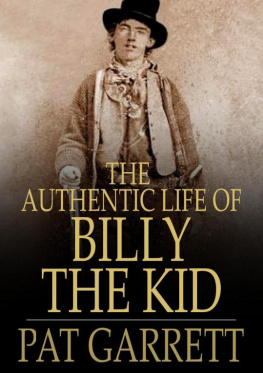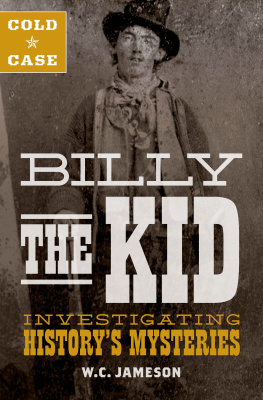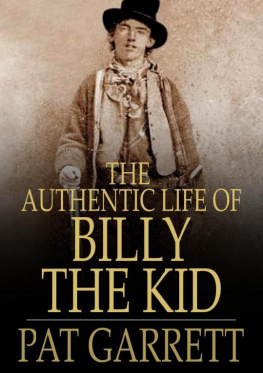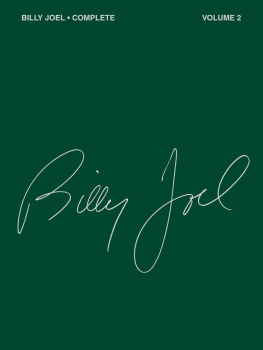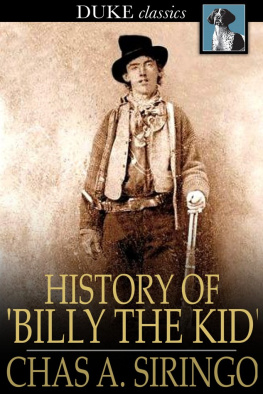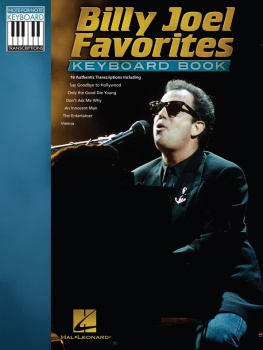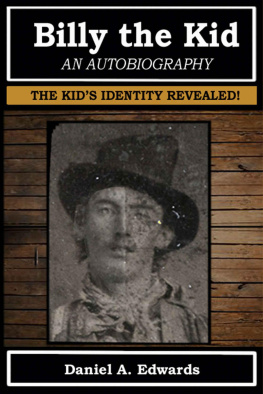Billy the Kid
A Short and Violent Life
Robert M. Utley
University of Nebraska Press:
Lincoln & London
Copyright 1989 by Robert M. Utley
All rights reserved
Library of Congress Cataloging in Publication Data
Utley, Robert Marshall, 1929
Billy the Kid: a short and violent life / Robert M. Utley.
p. cm.
Bibliography: p.
Summary: Examines the career of the young outlaw whose life and death were an expression of the violence prevalent on the American frontier.
ISBN 0-8032-4553-X
ISBN 0-8032-9558-8 (pbk.)
ISBN-13: 978-0-8032-9558-2 (pbk.: alk. paper)
ISBN-13: 978-0-8032-9566-7 (electronic: e-pub)
ISBN-13: 978-0-8032-9567-4 (electronic: mobi)
1. Billy, the Kid. 2. OutlawsSouthwest, NewBiography. 3. Southwest, NewHistory1848 4. Frontier and pioneer lifeSouthwest, New. [1. Billy, the Kid. 2. Robbers and outlaws. 3. Frontier and pioneer lifeWest (U.S.)] 1. Title
F786.B54U87 1989
364.1'552'0924-dc19 [B]
[92] 89-30022 CIP AC
For Paul Andrew Hutton
Friend,
Neighbor, Valued Critic
Contents
Illustrations
Following :
Following :
Maps
PREFACE
Quien es? Quien es?
With those wordsWho is it? Who is it?the youth threw away a critical moment of time. In the darkened bedroom, he could not make out the figure crouched at the head of Pete Maxwells bed. He thought he was among friends, and his hesitation cost him his life.
The crouching form belonged to Pat Garrett, sheriff of Lincoln County, and those fateful words told Garrett exactly who faced him. He did not hesitate, but grabbed his six-shooter from its holster and fired two shots point-blank. One slammed into the boys chest, the other rebounded from the adobe wall and splintered the headboard of Maxwells bed. Billy the Kid crumpled to the floor, dead. He was but twenty-one years old.
All that was mortal died on the floor of Pete Maxwells bedroom at old Fort Sumner, New Mexico, on that night of July 14, 1881; but almost at once an immortal Billy the Kid rose from the dead, ultimately to expand into a mighty legend of global impact. Few figures from the past have so profoundly stirred the human imagination. Among peoples everywhere, the name prompts instant recognition and evokes vivid images.
Stripping off the veneers of legendary accumulated over a century exposes neither hero nor villain, but a complex personality. Of the Kid as person and the Kid as outlaw, the reality both sustains and contradicts the legend.
By the time of his death, the public had already come to look on Billy the Kid as larger than life, a peerless outlaw in a land full of outlaws. Until near the end of his life, he could thank the newspapers for this standing. His actual exploits did not support the reputation. Then a sensational capture, trial, and escape gave validity to the newspaper portrait, and a violent death, publicized to the entire nation, fixed it indelibly in the public memory for all time.
Common outlaw, uncommon personality, inspiration for a giant in the pantheon of American heroessuch was Billy the Kid. So all-encompassing is the giant of legend that he has buried the man of reality.
Yet the reality is worth seeking. A legend cherished by all the world lends significance to a life that is otherwise of concern mainly to a handful of antiquarians. Because of the legend, the life invites scrutiny, to see if it can be compressed into its true human dimensions, and to discover what it tells about violence on the American frontier and, indeed, violence in American society.
ACKNOWLEDGMENTS
Either directly in the preparation of this book, or indirectly through my work on High Noon in Lincoln: Violence on the Western Frontier (Albuquerque: University of New Mexico Press, 1987), I have profited from the generous aid of many people, whose contributions I acknowledge with gratitude.
In Midland, Texas: J. Evetts Haley and his efficient and friendly staff of the Haley History CenterBeth Schneider, Robin McWilliams, and Cindy Burleson.
In Santa Fe, New Mexico: State Archivist Michael Miller and his able, always helpful associates at the New Mexico State Records Center and Archives; Orlando Romero, Arthur Olivas, and Richard Rudisill of the Museum of New Mexico History Library; Thomas Caperton, director of New Mexico State Monuments; Michael E. Pitel of the New Mexico Economic Development and Tourism Department; and Donald R. Lavash, formerly historian at the State Records Center and biographer of Sheriff William Brady.
In Lincoln, New Mexico: R. G. Miller, Robert L. Hart, and John Meigs of the Lincoln County Heritage Trust; Jack Rigney and his staff of the Lincoln State Monument; and Nora Henn of the Lincoln County Historical Society.
In Tucson, Arizona: Professor Harwood P. Hinton of the University of Arizona, whose wise counsel has been unfailingly helpful; Jerry Weddle, who generously shared his own new and important research findings; Bruce Dinges of the Arizona Historical Society; and David Laird, university librarian, and Louis Hieb, head of Special Collections, University of Arizona Library.
Also John P. Wilson of Las Cruces, New Mexico, outstanding authority on Lincoln County; Doyce P. Nunis, Jr., of the University of Southern California; Allen Barker of Pine Grove, California; Jack DeMattos of North Attleboro, Massachusetts; Frederick W. Nolan and Joseph G. Rosa of London, England; Rose Diaz of the University of New Mexico Library in Albuquerque; Philip J. Rasch of Ojai, California; Don McAlavy of Clovis, New Mexico; Byron Price of the National Cowboy Hall of Fame in Oklahoma City; Claire Kuehn of the Panhandle-Plains Historical Museum in Canyon, Texas; Thomas A. Mason and Connie McBirney of the Indiana Historical Society in Indianapolis; Eileen Bolger of the Denver Federal Records Center; Professor Richard Maxwell Brown of the University of Oregon; and Kenneth Pate of Azle, Texas, who assembled the photographs of firearms and furnished the technical data.
Finally, my heartiest thanks are reserved for two people who commented constructively and often decisively on the entire manuscript: Professor Paul Andrew Hutton of the University of New Mexico, to whom this book is dedicated; and Melody Webb of the National Park Service, who also happens to be my wife.
The Kid
Until the final few months of his life, the youth destined for immortality as the Wests most famous outlaw was known not as Billy the Kid but simply as the Kid. He acquired the label as a teenager, when he first began to associate with men. To the day of his death, his boyish face and slim figure stamped him as a kid. So did his behavior, uniformly characteristic of youth, untouched by adult maturity. A kid he remained throughout his short and violent life, ended by a bullet at twenty-one. More than any other trait, youth shaped the personality and directed the life of Billy the Kid.
The Kids origins are shrouded in mystery and buffeted by controversy. A corps of diligent researchers has tracked him in census records, city directories, baptismal and marriage registers, newspapers, and other sources. Discoveries have been tantalizingly suggestive but rarely conclusive.
That he was in Santa Fe, New Mexico, on March 1, 1873, is indisputable. On that day, as a lad of thirteen, Henry McCarty stood with his brother Joe as witness to his mothers marriage. The ceremony took place in the First Presbyterian Church, with the Reverend D. F. McFarland administering the vows as William Henry Harrison Antrim, age thirty, took in marriage the widow Catherine McCarty, age forty-three.
The ceremony probably formalized a relationship of some years duration. Bill Antrim and Catherine McCarty had known each other since 1865, when they met in Indianapolis, Indiana. A Civil War veteran, Bill drove a hack for an express company. How, when, where, and by whom Catherine had been widowed are disputed questions. Almost certainly she had moved with her two young sons from New York City, but why to Indianapolis is not known. She told the compilers of the Indianapolis city directory for 1868 that she was the widow of Michael McCarty.
Next page
